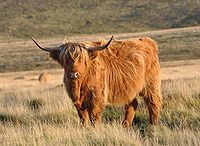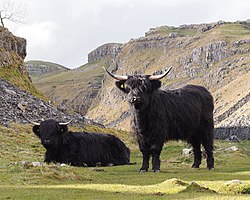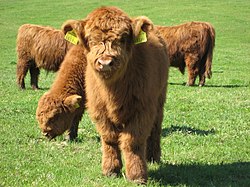Highland cattle
 A Highland cattle in the Highlands | |
| Conservation status | Least Concern |
|---|---|
| Nicknames | None |
| Country of origin | Scotland |
| Distribution | Worldwide |
| Use | Meat, can be used for milk on a domestic scale |
| Traits | |
| Weight |
|
| |




Highland cattle (Scottish Gaelic: Bò Ghàidhealach) (Scots: kyloe) are a Scottish breed of cattle. They have long horns and long wavy coats that are coloured black, brindled, red, yellow, or dun, and often primarily farmed for their meat.[1]
The breed
The breed was developed in the Scottish Highlands and Western Isles of Scotland. Breeding stock has been exported to the rest of the world, especially Australia and North America, since the early 20th Century. The breed was developed from two sets of stock, one originally black, and the other reddish.[2] Although there are several coat colors in existence since the late 1800s, most are caused by alleles at the MC1R gene (E locus) and the PMEL or SILV gene (D locus).[3]
Highlands are known as a hardy breed due to the rugged nature of their native Scottish Highlands which has high rainfall and very strong winds. Highland cattle have been successfully established in many temperate countries, such as Central Europe, and indeed in countries where winters are substantially colder than Scotland's such as in central Europe and Canada. Their hair is considered the longest of any cattle breed and gives protection during the cold winters. Their skill in looking for food allows them to survive in steep mountain areas. They both graze and browse, and eat plants that many other cattle avoid.
Commercial use
The meat tends to be leaner than most, beef because Highlands get most of their insulation from their thick, shaggy hair rather than subcutaneous fat. The coat makes them a good breed for cold northern climates and they are able to thrive in outdoor conditions that would defeat most other breeds of domestic beef cattle. As such, Highland cattle are able to produce beef at a reasonable gross margin from inhospitable land that would otherwise normally be incapable of rendering a profit agriculturally. Whilst the UK domestic and worldwide popularity of Highland cattle has made trade in pedigree beasts occasionally the most lucrative - mainly on account of their handsome appearance - they are at their best agriculturally when used to produce beef in a cold climate from poor pasture and forage.
Commercial success
Whilst the muscle of pure-bred Highland cattle is exceptionally tender and of high flavour, modern butchery and shopping trends tend to demand a carcass and a cut of meat of a different character. To address this market, Highland beef producers commonly run commercial Highland suckler cows with a 'terminal' sire such as a Shorthorn or Limousin bull. This allows the hardy Highland cow, grazed upon the rough hillsides of her natural environment, to produce a cross-bred beef calf that has the tender beef of its mother on a more modern carcass of high commercial value at slaughter, thus rendering a gross margin from her grazing that would have been impossible from other breeds in that environment. There is also a healthy demand from fellow producers of outdoor-reared beef who farm on more forgiving terrain, for Highland cross-bred bulling heifers: most often Highland cows crossed with the Shorthorn bull, for use as suckler cows. These cross-bred beef suckler cows inherit the hardiness, thrift and mothering capabilities of their Highland dams and the improved carcass configuration of their sires. Such cross-bred sucklers, further crossed with a modern beef bull such as a Limousin or Charolais to produce the finest quality beef are one of the mainstays of Scottish commercial beef production. It is this ability to pass on thrift and gross margin down the beef-breeding cascade that has secured this breed's place as a modern commercial beef breed.
The Highland cattle registry ("herd book") was established in 1885.[4] Although groups of cattle are generally called herds, a group of Highlands is known as a fold. They were also known as kyloes in Scots.

Domestic Use
The highland cow is highly valued for its success in domestic use. This is largely due to its ability to eat many plants and stay healthy. It also can produce a fair amount of milk, which is very high in butterfat.
Shows
For show purposes, highland cattle are sometimes groomed with oils and conditioners to give their coats a fluffy appearance. This appearance is more apparent in calves leading some outside the industry to call them fluffy cows.[5] Many also call the cows hariy cows, due to their thick coats.
See also
References
- ^ "Highland Cattle Society breed standard". Highlandcattlesociety.com. Retrieved 2012-03-09.
- ^ James Wilson (1909), "ch. VIII The Colours of Highland Cattle", The Scientific Proceedings of the Royal Dublin Society, Royal Dublin Society
- ^ Schmutz, S. M. and Dreger, D. L. 2013. Interaction of MC1R and SILV alleles on solid coat colors in Highland Cattle. Animal Genetics 44:9-13.
- ^ "Highland Cattle Society; the breed". Highlandcattlesociety.com. Retrieved 2012-03-09.
- ^ "Fluffy cows: Old Beauty practice gains attention". Associated Press. Retrieved 2013-06-21.
External links
- Australia: Australian Highland Cattle Society
- Austria: Austrian Highlandcattle Society
- Canada: Canadian Highland Cattle Society
- Czech Republic: Highland Cattle, eco-farm in Czech Republic
- France: French Highland Cattle Breeders Society
- Germany: Verband deutscher Highland Cattle Züchter und Halter e.V.
- New Zealand: New Zealand Highland Cattle Society and Independent Highland Cattle Breeders Academy
- Norway: Norwegian Highland Cattle Association
- United Kingdom: The Highland Cattle Society
- United States: American Highland Cattle Association
- Worldwide Directory: Highland Cattle World! Profiles over 40 Folds in 15 Countries around the World
- Genetics of the Coat Colors of Highland cattle [1]
